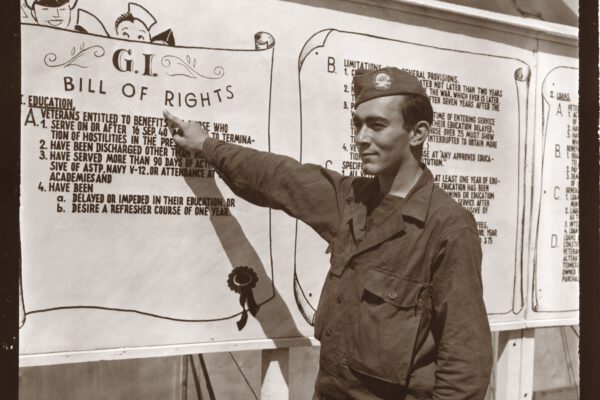By David A. Bergeron
Delivering high-quality postsecondary education to adult learners has long been a challenge. Traditional institutions of higher education are structured to recruit those soon to graduate from high school and, for the most part, are equipped to educate them once they get their high school diploma. Or at least that’s what they are designed to do best.
Despite this fact, public two-year colleges are only successful at graduating 40.2 percent of those that initially enroll within six years. Public four-year colleges do somewhat better, with 67.7 percent obtaining a degree or certificate within six years. Private nonprofit four-year colleges do better still, with 73.3 percent obtaining a degree or certificate within six years.[i]
When it comes to adults in ages 30 or older, however, colleges and universities do not do as well. Public two-year colleges are successful at graduating only 27 percent of adult learners with a degree or certificate within six years, or 33 percentage points less than those recently graduating from high school; public four-year colleges graduate only 32.8 percent, or 52 percentage points less; and private, nonprofit four-year colleges graduate only 35.5 percent, or 52 percentage points less.[ii]
Some policymakers—and more than few educators—held out hope that for-profit colleges would be better able to serve adults who had been out in the workforce for several years after high school graduation than more traditional public and private nonprofit two- and four-year colleges and universities. Those hopes were based on a number of factors, including greater flexibility in scheduling and location, pedagogy routed in the application of knowledge, and faculty that had real-world experience.
However, those institutions have also failed these older, working adults, with only 23.4 percent graduating with a degree or certificate within six years. By comparison, the degree or certificate completion rate for recent high school graduates from a two- or four-year for-profit college was 41.8 percent.[iii] Only at trade and technical schools did adults ages 30 or older complete degrees and certificates within six years at higher rates than those just out of high school (48.1 percent versus 27.5 percent).[iv]
As a federal higher education policy advisor and regulator, I often struggled to reconcile the goal of greater access for older adults with the lack of meaningful outcomes. Certainly, there are examples of high-performing public, private nonprofit and private, for-profit institutions that could justify continued federal investment, albeit with greater consumer disclosure and under stricter regulatory requirements. However, the problems of poor retention and graduation rates, particularly among students that had been out of the educational system for some time, often seemed unsolvable, despite a century of reliance on peer review-based accreditation that was expected to gradually—but inevitably—improve outcomes.
At the same time that federal officials were trying to address these challenges, the founders of College Unbound were working to develop and perfect a model that shows great promise for achieving significantly better outcomes for working adults and others that have been poorly served by our nation’s more traditional colleges and universities. If you spend time, as I have, around College Unbound, it is clear that the leadership is passionate about meeting the educational needs of the underserved, whether living in Providence, Rhode Island—a city where only 36 percent of the residents have an associate degree or higher[v]—or in a correctional institution. College Unbound leaders take the time to get to know each student’s story and connect that story with the institution’s mission. Connecting with each student’s story engages their passion to learn and gain as much as possible from their experience and creates an awareness that College Unbound’s leadership genuinely cares about the success of every student.
Unlike the models of community colleges—as well as some for-profit colleges—College Unbound meets on a very rigid schedule and offers a single degree program. College Unbound coordinates the courses, field studies, and in-depth projects to develop specific knowledge and skills and to promote deep learning. By focusing on delivering a degree completion program that leads to a bachelor of arts with a major in organizational leadership and change, College Unbound offers a unique opportunity for returning adult learners to be successful through an innovative, personalized, and student-based project curriculum. College Unbound makes sure that students have the resources they need to be successful, assuring that childcare is available whenever it is needed. Meals are a staple of the CU experience.
An important element of College Unbound’s approach is an emphasis on competency—what every College Unbound student must know and be able to do when they graduate—in 10 core areas: advocacy for self and others, accountability, creativity, critical thinking, reflection, resiliency, collaboration, communication, intercultural engagement, and problem solving. These competencies are gained through each student’s unique set of experience in courses, labs, and ongoing action research projects and are documented through a portfolio that is reviewed by a faculty committee that determines that the work and experience of each student satisfies one of the “big 10.”
Until now, College Unbound provided their educational program with almost no charge to students, relying on grants and other donations. However, it has long been clear that such an approach was not sustainable. It is unclear whether the approach of charging modest tuition and fees, largely covered by federal grant aid, will impact the success of the model.
As a result, College Unbound has recently had to build out the infrastructure necessary to deliver federal student financial aid. That has meant that they have had to think through the full range of policies necessary for student success that are compliant with federal laws, regulations, and policies. Because College Unbound was starting from scratch, the leadership team was able to ensure that they were as student-friendly as possible.
Thus far, those policies and procedures are largely untested, so it is too soon to know what adjustments will need to be made going forward. But College Unbound’s leadership is committed to keeping the policies and procedures as student-focused as possible.
As with everything College Unbound has done, the process of delivering financial aid involves a significant amount of personalization. Because College Unbound focuses on adults with previous experience with higher education, the prospective students often have student loan debt and other outstanding financial challenges. While the problem of federal student loan debt from previous enrollment is well known, with established policies in place to help address the problem, debt owed to prior institutions is another matter.
When a student leaves college with an outstanding balance on his or her account regardless of cause or amount, it is common practice for the institution to place a hold on the student’s academic transcript until the debt is satisfied. Sometimes these balances are the result of library or parking fines, while other times they are the result of federal financial aid being returned to the government, leaving a tuition and fee bill unpaid. Whatever the cause, often the only way to resolve the debt is to pay it in full so that the transcript can be released. Federal student financial aid can’t be used to pay the debt owed to the previous institution.
College Unbound, even prior to becoming eligible to participate in federal student aid, began to work one-on-one with students to resolve these and other financial challenges. As a result, even before students are formally enrolled, they receive financial literacy counseling and instruction to help them resolve their past financial challenges and get on the right track financially.
This is just one example of how College Unbound’s high-touch approach achieves good outcomes even for individuals who don’t ultimately enroll. At end of the day, the approach isn’t the least costly, but it will likely be highly effective in reaching a difficult to reach and underserved population that we need to have as fully prepared and equipped members of our community, state, and nation.
College Unbound was granted Candidate for Accreditation status by the New England Commission of Higher Education in 2018. Candidacy for Accreditation is a status of affiliation with the Commission that indicates that the institution has achieved initial recognition and is progressing toward accreditation. By receiving this status, College Unbound has gained the support and encouragement of the other institutions of higher education accredited by the New England Commission of Higher Education. Hopefully, these peer institutions will also learn from College Unbound what they can do differently to improve the outcomes for the students they serve.
[i] Source: U.S. Department of Education, National Center for Education Statistics, 2003-04 Beginning Postsecondary Students Longitudinal Study, Second Follow-up (BPS:04/09).
[ii] ibid
[iii] ibid
[iv] ibid
[v] Source: Colleen Campbell, “Those Left Behind: Gaps in College Attainment by Race and Geography,” (Washington: Center for American Progress, 2019) available at https://www.americanprogress.org/?p=471242. Interactive: College degree attainment is heavily dependent on race and geography, Overall college degree attainment rates by county, and enrollment and completion statistics for 12,000 U.S. college campuses, Colleen Campbell, https://interactives.americanprogress.org/maps/2018/12/Adult+Attainment+Report/index.html
If you have any questions or comments about this blog post, please contact us.


